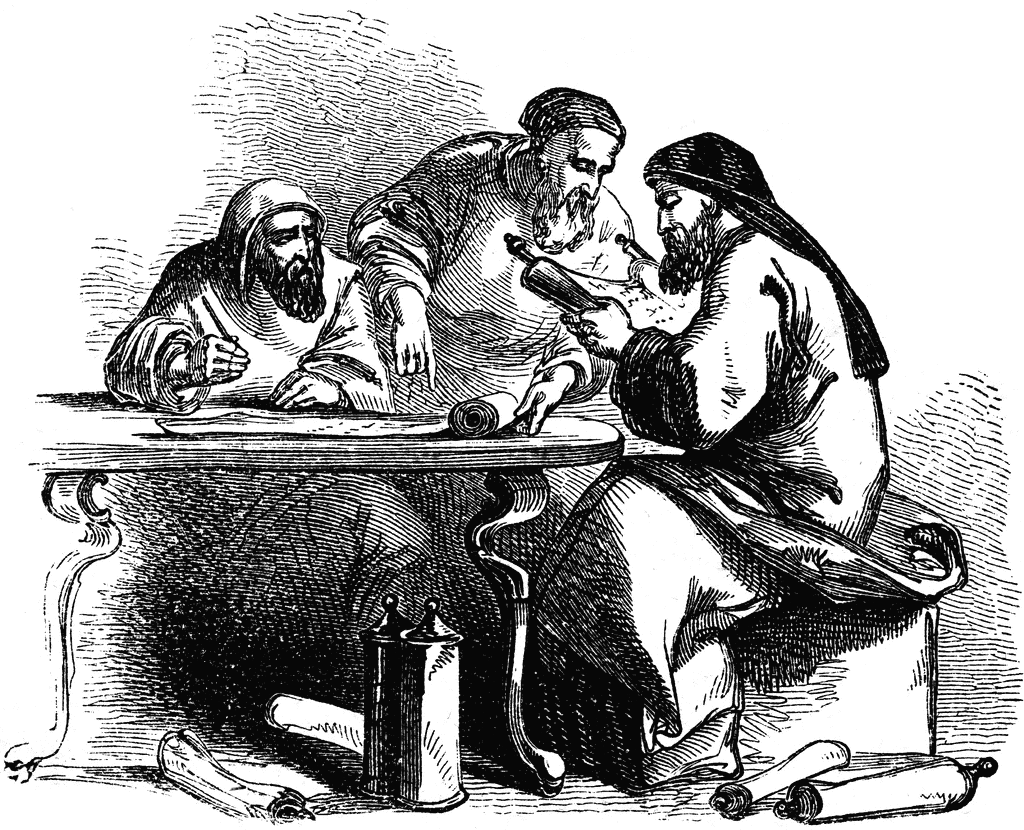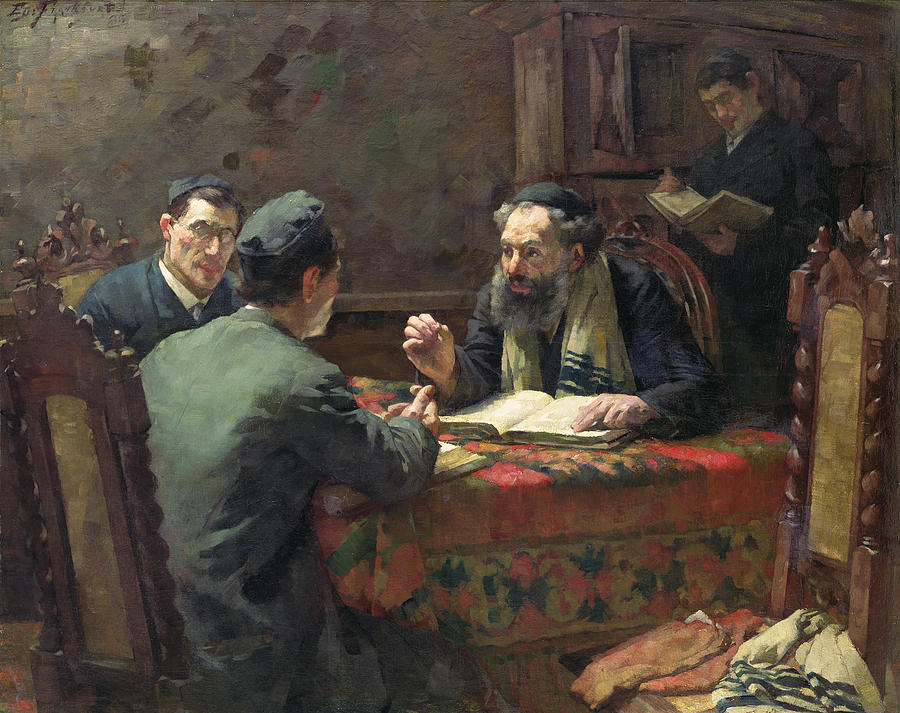Overview: An approach that reconciles both faith and critical scholarship, bridging somewhere in the middle of a divinely-inspired Torah and a man-made Torah.
Torah min hashamayim – the term used to describe this basic Orthodox principle of faith that Torah is the absolute Word of God. Many have taken this so literally to the point that they believed every word was said from God to Moses and that we can even learn laws from each and every word in Torah, well beyond what is implied from the simple intention of the Torah’s text.[1] Others take it to mean that the content of the Torah is from God yet written in the regular language of man, perhaps in Moses’ own words.[2] In this article we will present a modern approach to torah min hashamayim, one that attempts to reconcile faith with modern scholarship and archeological findings.[3]
We have argued for a divinely-inspired Torah based on the Covenant in “The Torah: Divinely-Inspired or Man-Made.” Yet, despite this divine nature, we have also discussed the human elements of the Torah, written in human language and containing possible narratival additions.[4] What we are to now propose is a far more radical approach, an approach foreign to Orthodox perspectives and one that would be regarded as heretical by some people.[5] Yet despite that, we need to examine the evidence wherever it takes us and if there’s a possibility for this model to be true, then the least we can do is present it as a possibility.
This model is a very dangerous model – in terms of belief; one that could make the divine system of Torah appear to be broken entirely. Yet despite the dangers, we shouldn’t exclude this possible model just because it doesn’t fit with our religious sensibilities. If this model is true, we can still rebuild a faithful religious framework and we will do so in this article.
What the Covenant tells us
We have argued extensively (here) for the divinity in the Deuteronomistic Covenant between God and His people Israel. We have seen the Covenant play out in history and even repeat itself, indicating a likely divine role. What would that tell us? At the maximum it tells us that the entire Torah is divinely-inspired and given directly from God. At the minimum it tells us that at least part of the Torah Law was given by God and that there is a unique relationship between the Jews and God, and that we are to serve our true God YHWH and not the foreign gods of other religions.
It’s easy and simplistic to take the extreme fundamentalist view that everything in Torah is directly from God. That approach would really make it easy to believe and appeals to much of our religious sensibilities. Yet despite being so tempting, there are clear flaws in the extreme approach as we will now point out.
What critical scholarship tells us
Critical scholarship often speculates, coming to conclusions much faster than the evidence tells us to (and The Rational Believer has many articles addressing those topics[6]). Yet overall critical scholarship has made a strong case in identifying the sources of much of Torah’s narratives and laws. These recent findings in archaeology and science have revealed things to us that our ancestors wouldn’t have known. We therefore have a responsibility to amend our beliefs according to what the evidence suggests we do – even though our great Jewish scholars of the past thought differently based on the limited and primitive science they had at their disposal.
We will not go through each case in great detail but we will give an overall line of reasoning to support this model of a man-made torah min hashamayim. We will show how the Torah borrows from other Ancient Near East myths and adopts laws from the great civilizations of old. Of course there are often answers to these parallels (as discussed in “Was Torah Influenced by Surrounding Cultures”[7]), yet these answers aren’t satisfying for many people and this alternative model can therefore assist in explaining why the Torah borrowed from other human documents of the time.
The Creation story of Genesis 1 parallels the Babylonian mythological tale of Enuma Elish: the flood story, that of Sumer’s Gilgamesh Epic. That is besides the scientific unlikelihood of a Great Flood and a 6-day Creation. The story of Moses’ birth in Exodus 2 parallels the birth stories of other great leaders in the Ancient Near East, such as the birth of Sargon of Akkad and of Horus of Egypt.
There are several anachronisms in Torah, suggesting that an author other than Moses (or God) wrote parts of the Torah (see here). There are also parts that seem to be a deliberate attempt to appear prophetical despite being written after the fulfilment of those “prophecies.” Examples include the Blessings of Jacob (in Genesis 49) and of Moses (in Deut. 34). These blessings, portrayed as prophecies of Jacob and Moses of what will happen in the future, describe the geographical situation of the Monarchical period in Judea and Israel as well as the financial classes of the tribes at that time. While I do believe in the concept of prophecy (see here), my first impression is that these specific alleged prophecies are actually written by much later scribes. Had it been actual prophecies, the content of the prophecies seems rather odd. Rather than conveying the entire future history of the Israelites, the chapter speaks exclusively of the Monarchical period of ancient Israel and ends there. There is no mention of the fate of most the Ten Tribes or the Second Temple era’s geography. This would suggest that these verses were written sometime during the Monarchical period and were thus unaware of later history. Similarly, since it was written during the Monarchical period, the author wouldn’t be aware that the kingship was to cease among Judah after the Babylonian invasion in the 6th century BCE which is why the author assumes that the Judean kingship will last forever.[8]
Besides all those narratival issues in Torah, there are the laws portrayed as coming from God, despite being almost exact copies of ancient Near Eastern laws that preceded Torah (for the religious response, see here and here). Most of Exodus 21 and 22 are strikingly identical, in both content and writing, to the famous Code of Hammurabi of ancient Babylon as well as parts of the Eshnunna laws.[9] The sacrificial system, described throughout Leviticus, parallels the sacrificial system of the Ancient Near East religions. Similarly, rituals like circumcision and the menstrual taboo are found all throughout civilizations that preceded Torah.
All this, and much more, are indicative of a human hand in the formulation of the Torah Law and Torah narratives. It is natural for human authors to be influenced by surrounding cultures and fashion their religion in a similar yet different manner. They were shaped by the ideals and customs of their society and that is evident in the Torah laws, such as those permitting slavery and killing rebellious children. Again, there are possible answers to these issues, though many people will find them to be apologetical gymnastics rather than reasonable explanations. That is why it is of importance to bring this model of torah min hashamayim as well.
The reconciliation
The approach here is a human-divine mixture in Torah. It is where human meets the divine in attempt to better serve It. Many of the Torah laws were man-made, according to this approach, and were later misunderstood to be laws given from God at Sinai (see Ex. 21:11). Akin to this, is the rabbinic law system of Halacha that is mostly man-made yet portrays itself as the Will of the Lord. God wants us to serve Him – as the Covenant suggests – yet many of the specifics in how we serve Him, such as laws, prayers, and inspiring narratives, are man-made – made in order to create a robust and survivable religion in the service of our God.
This doesn’t mean that all of Torah Law is man-made; it merely means that much of it is. Exactly how much was given from God at Sinai and how much was later developed and incorporated into the Torah’s text is questionable and beyond the point. It’s also possible that the general command to serve God was from God Himself at His revelation at Sinai, and He purposely left all the details for the sages to develop. An analogy is a king who requests a grand banquet from his servants, yet he leaves them the authority to decide on the exact details of what should be on the menu and how to design the banquet room. Thus, God commanded “serve YHWH and no other gods” and the details of how to serve God were left for the sages to develop. Just as the servants will design and decorate based on societal norms and customs, the sages as well developed a beautiful religion – influenced by, though different than, society – in the service of our God.[10]
The Junk DNA parable
To best bring out this idea, I like to bring a parable from what doctors call “junk DNA.” Our DNA is filled with millions of codes that make up who we are and what we do. But interestingly enough, most of these codes are useless, or junk, serving no purpose. It’s like a computer with millions of codes but only several thousand of them serve a computer function. The vast majority of our DNA are junk DNA, with only a tiny percentage actually bearing a functioning code that makes us who we are.
Scientists are still working on uncovering more about this DNA, but what appears to be is several categories within our DNA. First there is the DNA that makes us the incredible human machines that we are. Despite only being a tiny percentage of our DNA, these codes are enough to make us the sophisticated beings that we are. Some of the DNA seems to serve a purpose but scientists are still trying to figure out what function they play in the human biology. Some of the DNA is just plain-out useless; and others are, in fact, harmful, often causing cancerous growths within the bloodstream.
The comparison is a Judaism diverse with many elements. Some are actually divinely inspired, and some are man-made yet serve us satisfaction and make our society a better place. And some parts are even completely useless. Beyond that, some parts can be harmful – and it is our job to fix those issues. The bottom line, though, is that Judaism as a whole is a very functioning system that at one level or another taps into the divine in a way that no other physical practices can do. In a world void of spirituality, it is wisest to associate ourselves with Judaism that may contain at least bits and parts of spirituality and divinity that are otherwise inaccessible in this world.
The ramifications of this approach
While this approach may seem radical at first from an Orthodox perspective, it may not be that foreign to Orthodox theology after all. This concept is applied on a micro level in traditional Judaism, and here we are merely extending it to the macro level in order to answer many questions on faith. This isn’t to argue that this approach is a traditional Orthodox approach; on the contrary, this approach goes against much of Orthodox dogma. However, a similar idea and a micro level of this idea can be found within the Orthodox theology as we shall now explain.
Traditional Jewish thought pointed out textual corruption in Torah, recognizing that the Torah version we have today is not an exact accurate word-for-word as it was 3,000 years ago.[11] If we extend this logic from text to law, then we have our new approach to torah min hashamayim.
Traditional Judaism even applies this concept on the macro level when it comes to Halacha. Almost everyone agrees that most of the Oral Law and Halacha were man-made by the sages. They were not prophets conveying God’s Will,[12] but rather formulating laws that they thought would best keep Judaism alive and enhance the service of YHWH. This is why the Talmud regards these rabbinic-made laws as divinely-inspired, despite their clear human origin.[13] So if there were a group of scholars in ancient Israel who viewed themselves the same way the sages did in Talmudic times, they may have written down their laws and attributed it to Moses – just as the rabbis in the Talmud did!
This theory begins to get complicated once we bump into the question of legal reform. Should laws such as the ban on homosexuality (Lev. 20:13) be reformed on the assumption that they were man-made laws influenced by a primitive and barbaric society? Should the death penalty of Torah be restricted? These are all great questions that we as a community need to address, and there may not be clear answers just like many things in life. Some might argue that we should adhere to all the Torah’s laws on the possibility of that specific law being from God rather than man-made. Others might counter that we need to be inclusive and accepting, and unless we can know for sure that these specific laws were given from God directly, then we should not mistreat or restrict the natural human expressions of homosexuality or a woman’s role in a marriage, for example.[14] Ultimately, this is each individual’s choice to make and decide for themselves how to approach the authority of Torah.
___________________
[1] This is the approach of Rashi and many others in their commentary of Torah, as well as many sages in their legal exegesis in the Talmud.
[2] This is the approach of Rabbi Yishmael with his famous saying dibra torah kilshon bnei adam, Torah speaks in the language of man. Following this school of thought are the Torah commentators Rashbam and Ibn Ezra among many others.
[3] This is the approach of Rabbi Louis Jacob in his controversial We Have Reason to Believe and Prof. Benjamin Sommer in his Revelation and Authority.
[5] See Sanhedrin 99a where a Beraita says that anyone who says that even one verse in Torah is not from Moses, then he or she is considered an apikores, the talmudic term for a heretic. This may lead some people to deem the model we are proposing here to be heretical. While there may be some merit to calling this heretical, the matter is far more complicated. Despite these strong words in the Talmud, there have been traditional Jewish thinkers who have proposed that a few verses in Torah were not written by Moses (see here). Furthermore, the Talmud continues that even one who says that one of the rabbinic interpretations of Torah using a gezera shava or kal vechomer is considered a heretic. The rabbinic consensus is that these interpretations are of rabbinic nature – thus man-made – yet are still regarded as being from the divine. This can actually work with our approach here we the man-made gets a status of being divinely-inspired on some level.
[6] See section titled “Bible Criticism.”
[7] Also see https://www.etzion.org.il/en/torah-and-ancient-near-eastern-culture
[8] We will present a possible solution for this issue, and the reader can judge whether it answers the question or if the question is stronger than the answer. Rather than speaking of the future of the Israelites in general, Jacob wanted to address each of his own children separately, speaking of them as the future tribes they are to become. Therefore, Jacob only addresses them until the assimilation of the tribes into one another towards the end of the First Temple era. From that point on, there is almost no distinction between the tribes and thus it would make no sense to speak of the 12 tribes from that point in history. The history of the “12 tribes” ends at the end of the First Temple era and the history of the “Jews” takes over from that point on. Jacob may have avoided the whole discussion of the fate of most the Ten Tribes since his purpose here was to bless his children and speak of their bright future as tribes; a mention of the Ten Tribe’s fate would have been counterproductive.
As for the kingship of Judah lasting forever, we can suggest an alterative explanation of the verse. The kingship is said to happen until the arrival of “Shilo” to whom nations will subdue. Traditionally this mysterious “Shilo” has been understood as a reference to the messiah who is to come from the tribe of Judah. However, another possible explanation is that this Shilo can refer to the Babylonian empire – to whom nations subdued. Thus Judah’s dynasty will last until the arrival of Shilo, i.e. Babylon, at which point the dynasty of Judah was to cease. This untraditional explanation can answer the issue of “failed prophecy” that occurs if we interpret it to be referring to the messiah.
[9] We will bring one example (taken from here) found in Ex. ch. 21:
v28: If ox gores a man or woman to death, ox stoned, flesh not eaten, owner not liable.
v29: If ox had a history of goring and owner didn’t confine it, ox stoned and owner shall be killed.
v30: … or owner pays any ransom that is demanded in exchange for his life.
v31: … Law also applies to an ox that gores a son or daughter.
v32: … But if it is a slave that is gored, then the owner is fined 30 shekels.
v35: If ox gores another ox so that it dies, the two owners share the value two oxen.
v36: If ox had a history of goring and owner didn’t confine it, owner trades oxen (live for dead).
The similarities between the Bible and ANE laws are clear. However, it is the differences that are important! The Bible seems to polemicize in certain aspects against those ANE codes; e.g., while ANE laws don’t demand the death of the ox that gores a person, the Bible does. Thus, the Bible is more concerned about the sanctity of life (Greenberg). Also, while the ANE laws show partiality between certain types of classes (e.g., the “citizen” class has the best deal), the Bible has the same punishment when a person, son, or daughter is gored; they are all considered equal. However, similar to ANE laws, slaves in the Bible have a lower status and thus monetary retribution is allowed for a slave that is gored by an ox.
Eshnunna law code (Akkadian 1900 BCE)
- If an ox gored an(other) ox and killed (it), both ox owners shall divide the price of the live ox and also the equivalent of the dead ox.
- If an ox is known to gore habitually and the authorities have brought the fact to the knowledge of its owner but he has not had his ox dehorned; (if then) it gored a citizen and killed (him), the owner of the ox shall pay two thirds of a mina of silver.
- If it gored a slave and killed (him) he shall pay fifteen shekels of silver
Hammurapi (Akkadian 1792–50 BCE)
- If an ox, when it was going along the street, gored a citizen and killed (him), that case is not subject to claim.
- If a citizen’s ox was an habitual gorer and his city-ward notified him that it was an habitual gorer, but he did not pad its horns (or) keep watch over his ox and that ox gored and killed a member of the citizen class, he shall pay one half mina of silver.
- If it was a citizen’s slave, he shall pay one third of a mina of silver.
[10] Was there a Divine Revelation at Sinai according to this approach?
This approach is flexible to include a national revelation at Sinai, an individual revelation at Sinai (just to the Prophet Moses), or even no Sinai revelation at all (and the Covenant would come from later prophets). The advantage of this model is that it is so flexible and can be amended based on the evidence of archaeology, while still retaining a faith and commitment to God and the Torah.
However, the Covenant makes a Sinai revelation much more plausible than not. The whole context of the Covenant is the exodus from Egypt and the pact made at Sinai. Without Sinai, the stipulations and background of the Covenant make less sense. See “The Early Prophets on the Sinai Account” for a discussion of the historicity of the Exodus, specifically the section titled “the treaty context.”
Yet there still is the small possibility that the Covenant is authentically from God yet the Exodus and Sinai aspects of it were later additions by erred scribes, or embellishment to the story in the form of a theoretical revelation rather than a historical one. Admittedly, this no-Sinai model of torah min hashamayim still needs much more work done on it.
[11] Discussed extensively in “Is the Torah’s Text Accurate.”
[12] Cf Bava Metzia 59a-b. Also see Maimonides’ introduction to the Mishnah with his differentiation between Prophet and Sage.
[13] See Sanhedrin 99a regarding every gezera shava and kal vechomer being from God. Also see Talmud Yerushalmi Chagigah 1:8 and Yalkot Shimoni on Torah 405:1. Also see Tofsos Yom Tov on Mishna Avos 1:1. See Talmud Shabbos 23a regarding their authority being based on the fact that God entrusted them with the power to legislate in Deut. 17:8-11.
[14] A woman’s role in marriage was restricted in rabbinic law based on a (mis)interpretation of Deut. 24:1. Halacha only allows the husband to give a divorce, leading to many unwanted situations (called agunot) in which women suffer tremendously. That restricted role was common in ancient patriarchal society and has been preserved in Halacha until this day.




